|
|
|
15 October 07: Wach-uh Wach-uh Wach-uh
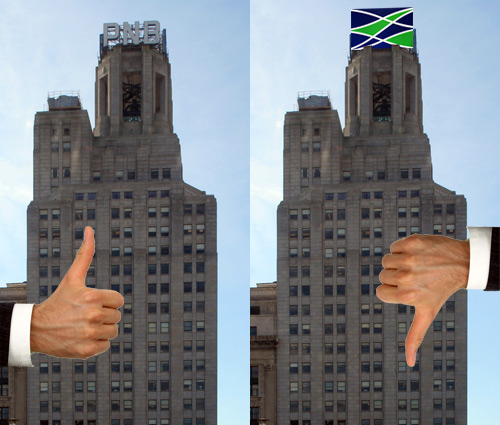
Big shout to my man HughE today, as he reports on Philly
Chit Chat that Wachovia hasn't given up on its plans to replace One South Broad's iconic "PNB" with its corporate logo. It was about two years ago or so that they
installed a test W right on top of the PNB, and it looked ridiculously stupid. The zoning notice, according to HughE, indicates that Wachovia wishes to "remove the
existing Four Signs that are on top of the building, replacing them with Two Worded Signs and Two Logo Signs that represent the existing bank inside the building".
But um, Wachovia? The PNB signs already do.
Philadelphia National Bank was founded in 1803 as the Philadelphia Bank, and by the time One South Broad opened as the Lincoln-Liberty Building in 1932, PNB was one of
the largest banks in the city. Having had offices there for years, the company officially declared the building its headquarters in 1956, when the PNB logo was adorned
to the four sides of the tower which houses the Founders Bell (which was cast as a tribute to John Wanamaker and which still rings on the hour). Across the state, what
would eventually become PNC was then Pittsburgh National Bank, so the PNB brand was challenged. Even though Philadelphia's PNB kept its brand at its branches, the
corporate name was changed to CoreStates, which in the mid-90s finally replaced the PNB identity at local branches. Charlotte-based First Union acquired CoreStates in
1998 for $16.6B, at the time the largest bank merger in US history. FU then merged with Wachovia in 2001 and the latter won the branding rights, from the corporate
towers in Charlotte to the sports arenas in South Philly to all the bank branches and ATMs across the eastern US.
So, to recap, Wachovia is First Union is CoreStates is PNB. Please leave the sign alone. Loews didn't go and replace "PSFS" with "LOEWS" now did it? And they're not
even in the same industry, let alone a new generation of the same company.
How's this for a deal: We won't bring up the whole thing about how another past incarnation of your company (not PNB) owned, traded and insured slaves if you don't place
your southern company's logo on our skyline. Deal?
The Philly Skyline -- fortunately -- has very little corporate branding on its skyline, and that which IS there is historically and locally based: Blue Cross, PSFS,
PNB, Aramark.
Zoning Board of Adjustments you realize this, don't you?
–B Love
|
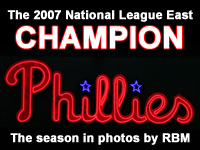 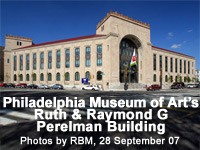  
15 October 07: Triple double
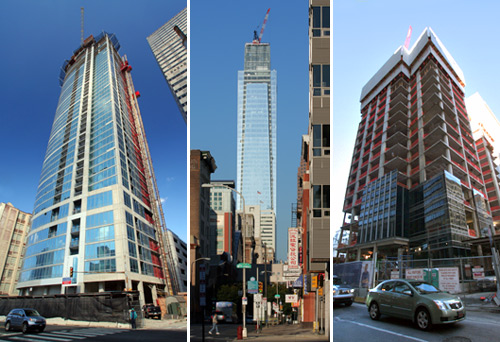
As promised, the big three got themselves a big photo update over the weekend, with over a dozen new photos each. Have a look:
• COMCAST CENTER
• MURANO
• RESIDENCES AT THE RITZ-CARLTON
We'll take a closer look at one of these and get to some other items of significance a little later today.
–B Love
|
12 October 07: Street View, Comcast Center
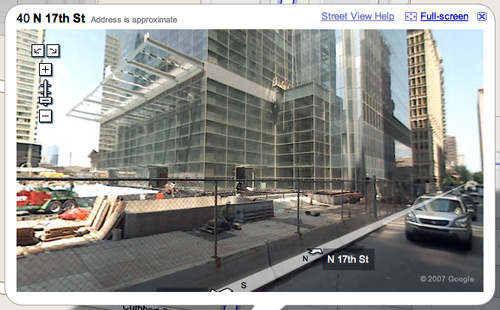
If you're online as much as I am (and at least 39.5% of you are), you've probably already zoomed in and out and through and around Google Maps Street View. The company that changed the world (and our attention spans) brought its
latest gaga-amazing-tech feature earlier this week to Philadelphia, adding us to a list of cities that already included New York, LA and Las Vegas.
Google's VW Beetles roamed our streets over
the summer (the summer that ended yesterday morning, apparently) with their fast and fancy 360° cameras. They covered a large swath of the city (see next graphic)
including West Philly, South Philly, the Northeast, some suburbs, some North Philly, Fishtown and Northern Liberties, and nearly all of Center City. It's not ALL of Center City because
the area around Rittenhouse Square -- the most desirable part of town -- has no coverage, presumably because angry, entitled residents were outraged when they saw these
vehicles, immediately forming a protest en masse like some brave Tiananmen Square demonstrator, blocking their passage while screaming "not in my back yard!"
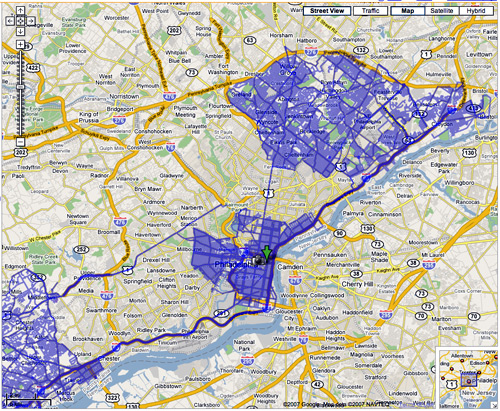
(Hey, it could have happened!)
What I find interesting about Street View is that it uses nearly up-to-the-minute data. That is, it's a lot newer than the stock they're drawing from for regular Google
Maps and satellite imagery. Observe: Comcast Center.
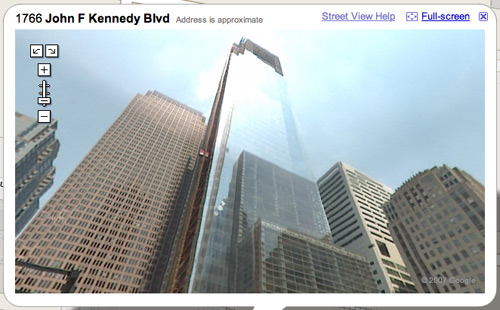
Comparing that against your Philly Skyline Comcast Center section, the images taken around Comcast Center were taken in early July,
perhaps the same day as the Two Liberty
Place tour.
It's kind of neat (I learned that word from Chris Wheeler -- I think it means "rad" or "dope") to look at three variations of the same location. Using the chronological
order of Google's technology, Comcast Center looks something like this:
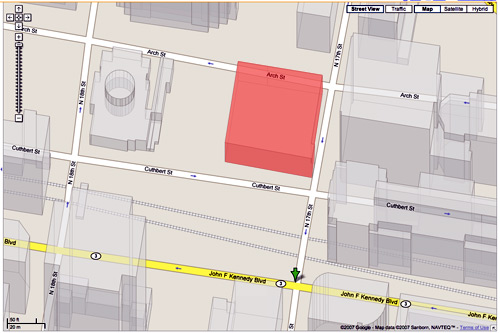
Regular Google Maps, with parcel display. The building in red is the Public Defenders Building, which was demolished in 2003 to make way for what was then still One Pennsylvania Plaza.
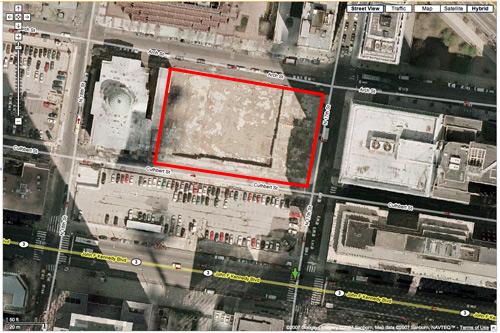
Google Maps satellite view. This image was clearly taken after that demolition and before construction started, so most likely it is from some time in 2004.
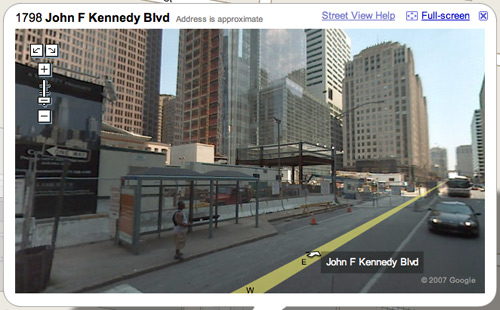
Google Maps Street View. Presuming it was taken the same time as the shot looking upward above, this one is from July.
Fortunately, the resolution is low enough that you can't see anyone making racial
jokes involving nooses. What in the fuck is up with this recent eruption of noose incidents anyway? Is it all a bunch of copycat nonsense stemming from the Jena,
Louisiana situation? A noose in a tree at the University of Maryland on a part of campus that houses minority group activity. A noose on the door of a black professor at
Columbia University. And now a noose allegedly being brandished by a white glass worker toward a black hoist operator, on a job site that, some funny waterless urinal pee
protests aside, has been virtually flawless in both its construction and its general public image and perception. Liberty Property and LF Driscoll rightfully suspended the
offender, but it seems almost certain that some sort of litigation will ensue. In this modern American world, how can it not? And in this modern American world, how
can anyone possibly think that bringing a noose to such a high profile job site is a good idea, whether in jest or to "make a point"?
The good thing in all of this, in immediate hindsight, is that Liberty and Driscoll did the right thing, and Comcast approved of their action. Hopefully this is the
largest extent to which this isolated blemish on an otherwise great work site will rise.
While we're on all of this Comcast Center talk, it's worth mentioning that a big update (as well as ones for Murano, Residences at the Ritz-Carlton, and maybe even 10 Rittenhouse Square) is in the works for the weekend and will be live Monday.
Time flies, dunnit? This morning's Philly Skyline Philly Skyline, from rooftop Fishtown just after sunrise today, shows that the glass of the crown of Comcast Center is
almost complete, bringing the end of nearly three years' worth of building into plain sight. Fret ye not, we'll mark the occasion.
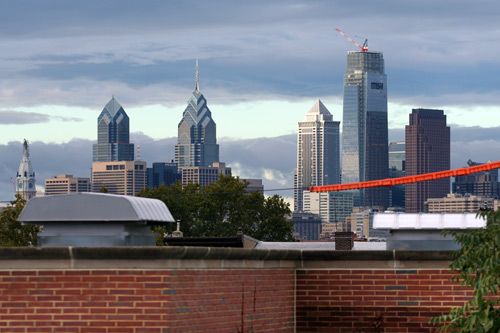
–B Love
Google Street View graphics from Google Maps Street View, obviously.
|
11 October 07: Don't hate, celebrate!
The Phillies Skyline 2007 season recap
|
 Here at Philly Skyline, we're doing what we've always done, just with greater frequency and with a higher volume of content. As it says on the about page, which has remained more or less unchanged since the current version of the site launched in February 2005,
Here at Philly Skyline, we're doing what we've always done, just with greater frequency and with a higher volume of content. As it says on the about page, which has remained more or less unchanged since the current version of the site launched in February 2005,
I have no mission statement or goal with this site . . .
But here on Philly Skyline, my friends and I are just sharing my experience right here in Philadelphia with our fellow humans.
I'm wearing a Phillies shirt on that page. That's not intentional, but it's also no coincidence, as a large part of my experience in Philadelphia has involved the
Phillies. Sometimes, when the 25.4% (according to our September survey) of Skyline visitors who generally visit for development news and The Skinny come across Phillies
posts (or reports from let's say Washington DC or across the river in Camden, where you can enjoy a great view of the Philly Skyline), I get emails telling me I suck or
that the site has lost its focus or something else along those lines.
No.
Philly Skyline is, again, about nothing and it's about everything. That includes the Phillies. In fact, in one of the older incarnations of the site, the "this web site is under construction"
graphic was that of Citizens Bank Park under construction. This is not a development or real estate web site. It is a PHILLY web site that happens to have lots of info
about development and real estate.
Something else I wrote to a reader nearly two years ago (surely in response to a Fire Charlie Manuel post) still holds true: Baseball is at its heart an urban
game, particularly in Philadelphia, where we once had two Major League teams competing within four blocks of each other on Lehigh Avenue, and then at the same ballpark,
before moving to South Philly in the urban renewal era. Nearly every Major League Baseball team plays in a downtown ballpark (Baltimore, Seattle, St Louis) or in an urban
neighborhood (Chicago, Boston, San Francisco), so it's quite natural for someone living in a city to have a fanaticism about a local team that plays 162 days a year, more
so during the playoffs when games are even more exciting).
So, with this (probably unnecessary) qualification out of the way, this is the ceremonious last post about the 2007 Philadelphia Phillies, the point of view taken from the
front row of the Arcade level.
It was the best of times, it was the . . . blurst of times!
 When the Phillies landed Freddy Garcia in the offseason, it propelled Jimmy Rollins to make his famous "team to beat" statement, which propelled me to make my first season
ticket purchase since 2004, the inaugural season at Citizens Bank Park. I believed him, and though it took literally the entire season, down to the last out of the last
day, he was right.
When the Phillies landed Freddy Garcia in the offseason, it propelled Jimmy Rollins to make his famous "team to beat" statement, which propelled me to make my first season
ticket purchase since 2004, the inaugural season at Citizens Bank Park. I believed him, and though it took literally the entire season, down to the last out of the last
day, he was right.
Along the way, the derision of Mets fans, appalled by J-Roll's statement so soon after their 2006 division title (after which they watched the St Louis Cardinals win the
pennant on their home grass of Shea Stadium), was louder than even their most obnoxious LET'S GO METS chant. And along the way, he hit .346 with six homeruns and 8 stolen
bases against the Mets. The Phillies took 12 of 18 games against them, including two sweeps at Shea and the most exciting four game sweep I have ever seen, at Citizens
Bank Park in late August.
That record against the Mets proved vital in their run up to the end of the season, as the Mets collapsed at the end and the Phillies seized the moment, taking the
division title. It's too bad they ran into the Colorado Rockies steamroller, but considering all the injuries (Gordon, Myers, Howard, Utley, Victorino, Garcia, Lieber,
Hamels, Barajas . . . just kidding), they were well accomplished for 2007. Better, considering the team's nucleus -- Rollins, Utley, Howard, Victorino, Ruiz, Hamels,
Myers, Kendrick -- has an average age of 26 and a quarter years, things finally look pretty optimistic down on Pattison Ave.
Aaron Rowand endeared himself to Phillies faithful for two full seasons, but it seems pretty unlikely the Phillies will match the raise (from a current salary of $4.35M)
his agent is able to get him. From the Daily News:
"There are many things to consider,'' [Rowand's agent Craig] Landis said in a phone interview last night. "Aaron enjoyed his time in Philadelphia. Yes, he's a
fan favorite in Philadelphia, but he was a fan favorite in Chicago as well and they let him go."
. . .
"If he's a fan favorite and a player favorite, then there is only one thing left - how much does the front office appreciate him?" Landis said.
It would certainly be nice to keep Rowand around, but Shane Victorino covers plenty of ground in center (he was a great fill-in last year when Rowand was hurt), and
between Michael Bourn and Jayson Werth, they should be able to spell rightfield (and the late innings after Pat Burrell has been pulled). Besides, never mind Aaron
Rowand's raise -- Ryan Howard finally stands to earn the money he's long been due with a renegotiation coming.
 It's too bad the Phillies didn't try Tadahito Iguchi at third after his excellent fill-in during Chase Utley's month out. If it had worked out, he could have led the
charge to take third base next year. Iguchi won't be back, nor does it seem likely that Abraham Nuñez will, so unless the Phils somehow land Mike Lowell or A-Rod
(HA HA), Greg Dobbs and Wes Helms will resume sharing duties.
It's too bad the Phillies didn't try Tadahito Iguchi at third after his excellent fill-in during Chase Utley's month out. If it had worked out, he could have led the
charge to take third base next year. Iguchi won't be back, nor does it seem likely that Abraham Nuñez will, so unless the Phils somehow land Mike Lowell or A-Rod
(HA HA), Greg Dobbs and Wes Helms will resume sharing duties.
Most important for 2008, though, is obviously pitching. The Freddy Garcia acquisition was unfortunately a bust, and the Adam Eaton one was predictably a bust. We passed on Joe Borowski in the offseason, and he ended up leading the American League in saves
(but with an ERA over 5). There's not a whole lot of A-grade talent in this season's free agent pool, but
as it's been said a million times, Pat Gillick has built a number of winners, and it seems unlikely that he'll want to head into retirement next year following little more
than just being swept out of the first round of the playoffs.
And then there's Charlie. So many times over the past three years, I've shaken my head in disgust and hoped that team management would have the sensibility to fire him,
but making the playoffs after all of the obstacles this year seems like a good enough pass to re-sign him for two more years. When Joe Girardi is waiting for a job. And
Joe Torre could be looking for one.
Welp . . . the players like him and have rallied for him, so they got what they wished for. Charlie's back in 2008 for the Phillies, and hopefully the playoffs will be
too. In looking to the future, Philly Skyline salutes the present, or most recent past. This latest photo essay is of the National League East champion Philadelphia
Phillies and their 2007 season, taken over the course of 23 games and arranged in chronological order, from opening day to the playoffs.
–B Love
|
   
10 October 07: Aloof at the Airport
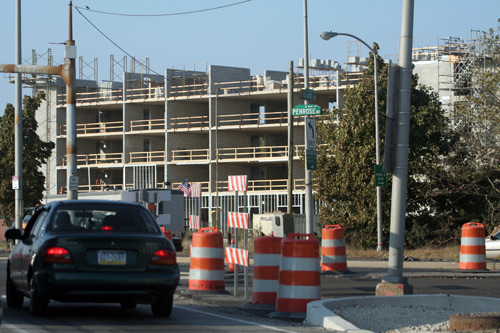
About a week ago, I got an email from Russ in King of Prussia reminding me that the construction of the Aloft Hotel near the airport was coming along nicely. My immediate
reaction was "oh shoot, that's right . . . totally forgot about that, even in light of recent hotel talk." Then I forgot again. Good thing Monday was Columbus Day.
I decided to reflect on the 515 years that have borne American Indian genocide, the enslavement of blacks, the building of the American industrial powerhouse on cheap
immigrant labor, and the hole the Bush administration has dug this country into -- never mind the war and the approaching-4000 American deaths (to say nothing of Iraqi
death), the Canadian dollar is even with the American dollar, people . . . the Canadian dollar! -- by heading into the woods by myself. Instead of the comfort of
the Wissahickon or a hike up in Pennypack, I opted for the marshy mess at Tinicum, the John Heinz Wildlife Refuge (hence yesterday's baby update).
With a busted bike and Septa as my only transit option, I drove. I exited southbound 95 at Island Ave, which at the exit is not Island Ave at all, but Enterprise Ave.
Enterprise Avenue is quite possibly the ugliest place in all Philadelphia: low lying warehouses, loading docks, parking lots and a big, barbed wire fence that keeps you
out of Philadelphia International Airport. There are no homes, no shops, no bars, no reason for any person not employed there to ever really be there. (Fort Mifflin is a
quick jaunt off of Enterprise Ave -- when you see a screaming 747 about seventeen feet above your head, turn left.)
Enterprise Ave eventually becomes Island Ave with a forced right turn where the airport last expanded northward. The ugly modern industrial stuff continues up to
and past the intersections of Penrose Ave (which takes you across the Platt Bridge back into South Philly) and I-95 again. All of this stuff, it would seem, must be within
the lexicon of "the Gen X crowd", as the New York Times happily described the
target audience of Starwood Hotels' latest boutique concept, Aloft, which is building a
brand new 136 room hotel at Island and Penrose. To borrow from The Illadelph,
A sphincter says what? We would sooner recommend a visitor stay at the Holiday Inn Express Midtown, than at any hotel near the Philadelphia fucking
airport.
Right? This is worse than opening on City Line or in Mount Laurel. Oops, Aloft already has its brand in Mount Laurel; lots of NFL Films execs fit the profile, don'tcha
know.
The Airport is obviously the region's largest hub of travelers -- transient folks in need of a bed -- but to open this type of modern boutique hotel on Island freaking
Avenue is just inconsiderate. How many Gen X (ugh) hipsters (oof) do they expect to be held up on an overnight layover and won't go the extra mile and head
into Center City via a cab or the R1 to actually, I dunno, experience Philadelphia?
The building itself isn't bad; in fact, it's kind of nice.
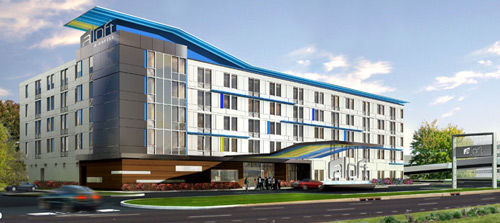
Image by Starwood Hotels and Rockwell Group
But it's drag and drop architecture. Every one of the Aloft hotels follows a standard model, designed by David Rockwell of the Rockwell Group, spruced up by splashes of local flavor. Let me guess: there will be framed pictures of Geno's, Donovan McNabb, and the skyline from
South Street Bridge (prior to Comcast Center and Murano, natch), and it will be Philadelphia's official boutique hotel, just like the Home Depot is Philadelphia's official
home improvement store and Philadelphia's official beer is Budweiser. From the Aloft Philadelphia Airport press release:
"Philadelphia is home to the Liberty Bell, the Declaration of Independence and the best cheesesteaks in the nation," said Ross Klein, President of Starwood
Luxury Brand Group and aloft hotels.
They serve cheesesteaks elsewhere?!?
As a Vision of W Hotels, aloft is shaking up the lodging industry with urban-influenced design, accessible technology, style and a social atmosphere.
aloft* offers a total sensory experience, with guest lofts featuring loft-like nine-foot ceilings and oversized windows to create a bright, airy environment.
. . . with views of the Airport, I-95, parking lots and oil refineries.
* - Just like I refuse to type "iTunes" and "iPod", I refuse to type "aloft" at the beginning of a sentence.
Urban-influenced? Jigga what? Island and Penrose . . . urban-influenced. All righty then.
Like I said, it's a pretty cool looking building, and the rooms and public areas (bars) will surely be top notch. And, Philadelphia is in serious need of hotels,
especially those of the young and fashionable variety. But who is going to stay there? What local Gen X'ers are going to visit the bar there? It's nowhere
remotely close to Septa's R1 station, and a cab ride from (or to) Center City comes with a base fare of $27.50.
I think it's great that Starwood wants an Aloft here in Philadelphia, even as their W prepares for construction at 12th & Arch. But at the Airport? Why not one of the lots
in Old City? (I mean the ones there prior to the demolition of historic structures.) Why not one of the empty parcels around Rittenhouse Square? Cripes, why not University
City? An Aloft there might make a nice companion to Rockwell's earlier efforts at Pod.
Time will tell how well received the Aloft Philadelphia Airport becomes, but before its construction is even completed, it seems to me like another Philly missed
opportunity.
–B Love
|
   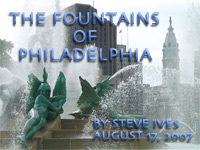
10 October 07:
The Philly Skyline Record Review:
In Rainbows by Radiohead
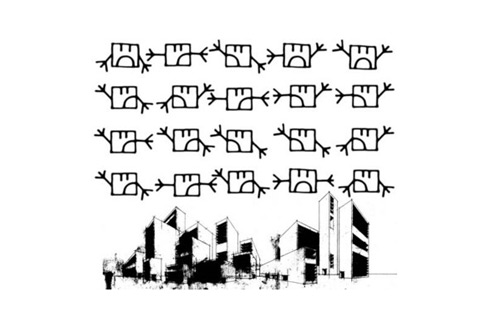
This has absolutely nothing to do with Philly or its Skyline. Well, maybe it does . . . because it's going to score many of our interpretations of our Philly Skyline
(taken both ways). Whatever the case, it's huge: Radiohead's new album is officially out, as of 2:42AM our time, when I got via email my pre-ordered link to a zip file of
mp3s that I paid whatever I wanted for.
That's why this is so significant: Radiohead finally completed its obligation to Capitol Records -- big corporate music -- and being the benders they are, wanted to take
their music in their own direction. They've done so by handling the entire production on their own and selling it (for now) exclusively on their web site: buy a discbox
that comes out in December for 40£ and get the album on cd and vinyl, a bonus cd of eight other tracks (In Rainbows B), artwork and photos, a booklet of
lyrics, AND the download today. Or, you can just buy the album download -- a zip file of mp3s, just like all the albums pirated and hosted on sites like MegaUpload and
SendSpace and RapidShare and posted on such message boards as Ateaseweb, a semi-official Radiohead fan site -- today, for whatever old price you feel like paying. I paid
2£, or thanks to the Totally Awesome value of the American dollar, about $4. My buddy Doug paid the same thing
and didn't feel cheap. Much.
I paid 2 pounds for the new Radiohead album -- knowing that I didn't have to pay ANYTHING if I didn't want to -- and somehow I still felt just a little guilty
about paying so little. BUT . . . then I thought about it, and realized that with no label, no secondary electronic distributor, the 2 pounds I paid is probably more than
they would have gotten from me if this was released traditionally. Do you think the band gets $4 for each unit sold when they are under contract with a major label and
distributor? No way. Plus -- like I said -- just the fact that there is no price, that you can really just pay whatever you want to pay -- made me feel like I should pay
SOMETHING. Whereas if this was your basic $13 album -- I would have found it on some bittorrent site and not paid a penny. I mean that's just me being honest. I'm sure
I'm not alone. If other bands let me say "Sure I'll give you a couple dollars for this" I'd be way more likely to actually pay for music.
It's hard to believe, but it's been ten years since OK Computer came out. I truly apologize for being Rolling Stone Guy (seriously), but that goddamn record shifted the
way I listen to music. My tastes were reared on my mom's Prince and Earth Wind & Fire records and then the 90% hip-hop (Public Enemy, LL Cool J, Beastie Boys), 10% hard
rock (Slayer, Hendrix) I picked up in high school. When I got to college in '94, it was almost all hip hop (Illmatic, Ready to Die and Southernplayalisticadillacmuzik all
came out that year), and I started DJing. (It's where the handle B Love comes from . . . me and Warren Kaos were behind the 1 & 2 -- Love & War -- for two years on
Thursday nights, yo.) Being exposed to the different records the different DJs spun (Yo La Tengo, Aphex Twin, Steve Earle, Stereolab) broke that bubble a little bit, but
what really opened me up, like any good college student, was doing bong hits and playing Mortal Kombat II on Sega Genesis in my neighbor's dorm room with Pink Floyd's
Pulse (the live double cd of the '94 tour, which included my introduction to Dark Side of the Moon and which had just been released) in the background. It seeped
in.
Summer of '97 was great for me . . . my On The Road before I went on the road. I stopped taking pointless college courses, worked full time at a steel factory, went
skydiving, spent a lot of time on the Appalachian Trail, and kept DJing. But, as DJ Shadow said the year before, hip hop sucked. The biggest hip hop releases of '97 were
Biggie's Life After Death, Wyclef's Carnival, Wu-Tang Forever and Ma$e. BORING. That's when I decided to take OK Computer, the new record by this one hit wonder
("Creep") band whose second album (The Bends) my dorm roommate played and which wasn't bad, off the rotation shelf for a weekend spin. A few pulls of the peace pipe and 60
minutes of late night listening on hip hop DJ headphones later . . . whoa.
* * *
 Ten years later, Radiohead is everyone's favorite band, but no one would admit it. Everyone understands them on a deeper level than anyone else. Their music is me-time
music, not party music, even if they're still capable of danceable rockers. That's what makes the hype machine of the past ten years so fascinating . . . They are Rock
Gods, largely of Thom Yorke's unintentional intentional anointing, yet the uninterested general public -- which doesn't get Radiohead, MAN -- probably
couldn't pick a single song of theirs (Creep aside) out of a bin of a thousand audio samples.
Ten years later, Radiohead is everyone's favorite band, but no one would admit it. Everyone understands them on a deeper level than anyone else. Their music is me-time
music, not party music, even if they're still capable of danceable rockers. That's what makes the hype machine of the past ten years so fascinating . . . They are Rock
Gods, largely of Thom Yorke's unintentional intentional anointing, yet the uninterested general public -- which doesn't get Radiohead, MAN -- probably
couldn't pick a single song of theirs (Creep aside) out of a bin of a thousand audio samples.
Ten years later, the music industry is different too. Napster came and went. CDNow, its corporate answer, came and went, swallowed whole by Amazon, throwing the whole
Napster download concept out the window. American Idol happened and is still happening, sadly. Itunes made downloading okay and profitable. Amazon (very recently, like
within the past month) changed its mind on downloads and followed Itunes' lead, making songs available for purchase in mp3 format, like itunes, except those songs which
are only sold as part of a whole album, like itunes. Radiohead said screw all of you guys.
Since Hail to the Thief arrived with a bit of a thud (it took them two and a half years after Kid A & Amnesiac to record their last big corporate record and take it on a
big corporate tour), over four years have passed, and web sites and message boards which weren't as prevalent ten years ago have predicted back and forth when and how
"LP7" would be released. Then bam, ten days ago, they announced on their web site that a new album called In Rainbows would be available for download today, exclusively on
their web site, and you could pay whatever you bloody well want to pay for it.
And here it is. In the time it's taken me to write this, I've played through it twice. Most of the songs are not new -- they played them on their tour last summer,
including the two-night run at the Tower Theater, whose set has been mp3-available since about ten minutes after the encore -- but they're better. In Rainbows is the
product of one band and one producer's studio magic, with no extraneous outside input and no early leaks and, in spite of the hype hype hype, it's still fresh and new and
unpredictable and beautiful. As corny as it sounds, Radiohead really is The Greatest Band In The World.
–B Love
Radiohead graphic from Radiohead.com, Tower Theater concert photo by Flickr user mi.a
|
9 October 07: 57 varieties of stench
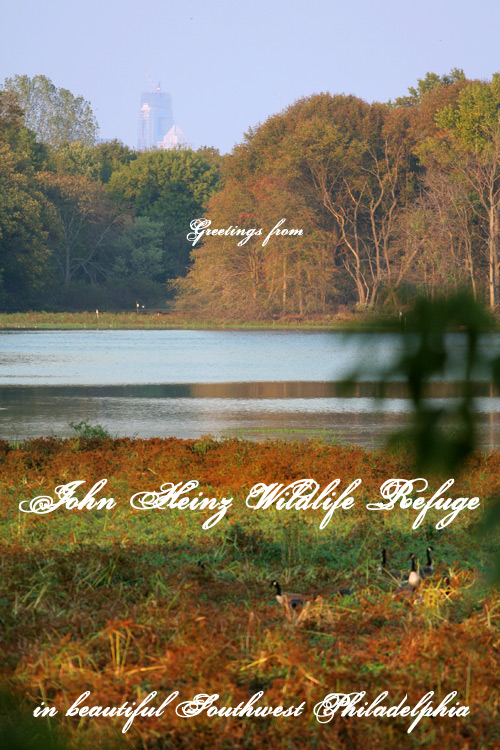
For being as nice a respite as John Heinz Wildlife Refuge is, it sure does have some . . . unpleasant smells. Guess being a marshland wedged between an
international airport, an interstate highway, an oil farm, a waste treatment facility and being fed by a superfund creek will do that to ya. Shame. It really is a
nice place, especially if you're into birds.
Enter on the Ridley (95 exit) side if you want to hike through woodland trails to the marsh; enter off of 86th & Lindbergh in Southwest Philly to
check out the interpretive center and find out the types of birds you're seeing and exactly what all is polluting the waters there.
The photo above is one of a small handful in a recent update of Comcast Center photos. Murano
and Residences at the Ritz-Carlton each got baby updates too. Baby updates just like this baby update, baby.
–Baby Love
Dancing white people are funny.
|
8 October 07: In the pink
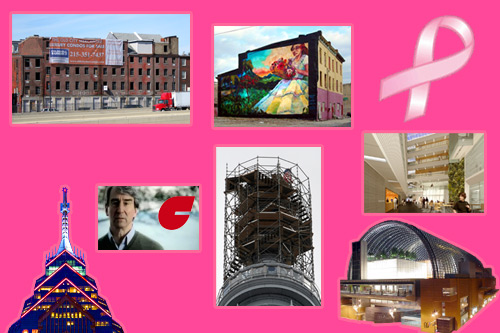
October rolls onward, and on your Skyline that means one thing above else: pink.
October is of course Breast Cancer Awareness Month, with events to raise (money and) awareness about breast cancer, its prevention and treatment. As usual, it's
punctuated by pink ribbons worn on the breast and Lights For The Cure: pink lights adorning landmark buildings like Boathouse Row, Mellon Bank Center and the
Inquirer Building. A complete list of buildings in the Philly area (including Camden and the Main Line) is found at CBS3, and a list of events for the month is found on the Philadelphia affiliate of the
Susan G Komen Race for the Cure's web site.
A glance upward at your pink skyline sounds like a Monday Mornin' Lookin' Up . . .
- PINK VOID: Still have that list of buildings in pink up? Notice One missing? (Capital 'O' is intentional, because) One
Liberty Place is dark. The past few nights, the former champion of the Philly Skyline has been neither Phillies red nor boobies pink, but rather it's been
completely dark. Are they finally migrating to LEDs? Are they protesting? Are they against breast cancer awareness? Only they know.
However, not everyone dislikes One Liberty's darkness. Bill from G-Ho writes:I was just wondering if you had noticed how cool Liberty 1 looks without
the lights on its crown . . . It's a dark, hulking monster in the night skyline.
It looks bigger without the lights on; mostly, I think, because the lights don't extend the full width of the building's lower floors and it seems thinner with the
lights on.
- MURAL ARTS AWARENESS MONTH: A friendly reminder, for those of yous who missed 6ABC's mural special with Tamala Edwards and
Matt O'Donnell on Saturday, October is also Mural Arts Month. As mentioned last week, tons of mural events line the calendar this month including Murals and
Meals Tours (guided mural tours that end with dinner) and the dedication of nine new murals including ones at North Philly's historic Uptown Theater and a new
Harriet Tubman mural at Germantown & Indiana, which may help to erase the memory of Thomas Jefferson University demolishing the one on the old I Goldberg building
to make way for its enormous parking garage.
The full list of events is over HERE.
- WILLIAM PENN WAX JOB AWARENESS MONTH: One unintentional October event is the continuing, fast moving wash-n-wax of one Billy
Penn atop City Hall. The scaffolding is fully erect (especially if you view if from the Ben Franklin Parkway), and Moorland Studios is hard at work. The Inquirer's
Tom Gralish (who, as an aside, has been on a freaking roll) got himself a Bill's eye view. The gallery is great, and it is HERE.
- CORPORATE BANKING AWARENESS MONTH: OK, OK, enough with the awareness month. Last week, Commerce Bancorp and TD Banknorth
announced they were merging, which in effect meant that the latter, based in Toronto, was gobbling up the former, based in Cherry Hill. On the surface, it sounded
like a bit of a bummer with another local bank with a strong presence losing its identity. However, the Courier-Post reports, Commerce will retain its
identity.
Under the deal, the signature Commerce red "C" will remain on the bank's 460 branches -- and will go up on branches in the Greater
Philadelphia and North Jersey markets now bearing TD's Banknorth signage. . . . TD executives pledged to preserve Commerce's retail-based model of convenience and
courtesy but stopped shot of committing permanently to such amenities as seven-day-a-week banking.
There was no mention of the fate of Penny Arcade or the free lollipops, nor whether Commerce's ads with Elaine Benes and Regis & Kelly would be replaced by TD's
with Sam Waterston not looking at the camera. WHY ARE YOU LOOKING OVER THERE IF YOU ARE TALKING TO ME??? I s'pose they're better than the Adobe Premier
filter Talk To Chuck Schwab ads.
- OLD CITY MARITIME HISTORY, COLLAPSING ONE BLOCK AT A TIME: Back in March, yr Skyline observed,
While Old City has grown in leaps and bounds in the past 5-10 years, tipping the scales in property values, art galleries and weekend meatheads, those
leaps and bounds were leapt and bounded over obvious development sites (like the multitude of parking lots and rehabs in waiting), some going as far as inexplicably knocking
down historic buildings that make up a city's invaluable fabric.
Fortunately, the omnipresent Girard Estate's beautiful Mercantile block of North Front Street was not one which met the wrecking ball.
Well OOPS, we may be proven wrong. On Friday, Plan Philly reported that the Girard Estate block
is in danger of collapse. Sound familiar?
These particular buildings on Front Street just above the ghastly Market Street bridge across I-95 have stood vacant for years, but BRP Development has flown its banner on them all year, announcing the forthcoming condos of Old City Mercantile. (Both of those web sites will stretch your browser to fit your entire
window. People love it when web designers tell them how large their browser should be, especially when they're on a 1680 x 1050 imac. Love it.)
Apparently, the "unparalleled restoration of the historic Girard Estates [warehouse] building" has stopped midstream -- after removing the original
windows and tearing out the back wall -- and the nearly 200 year old structure appears ready to collapse. The PlanPhilly link above has photos of its current
condition.
Unsubstantiated hearsay says that the current owner, who paid less than $2M for the property two years ago, is shopping the property around for $5M, and everyone
knows that vacant land is easier to move than that which has buildings on the National Historic Register in need of serious work. The Old City Civic Association
is on the case, but it will be interesting to watch it play out. Demolition by neglect is no strange concept in Philadelphia, but it can be overcome, as it was
with Biddle Hall and Toll Bros' Naval Square development. Stay tuned.
- THE KIMMEL IS TRYING TO RIGHT ITS WRONGS: In a great piece in the Sunday Inquirer, Peter Dobrin laid out the current goings-on at the Kimmel
Center and how its new chief Ann Ewers, an import from Utah, is handling them. In addition to more bureaucratic necessities like balancing the books and filling
the gap left by construction overages, plans include dealing with the rooftop garden's overbearing summer heat, improving the acoustics at Verizon Hall, and moving
the ticket window outside to the corner of Broad & Spruce, where there is now only an unbecoming black cube. On either side of the new ticket window could be new
LED screens, designed by MGA Partnership, which would display past and future performances from inside.
- DREXEL, THE LATEST IN GREEN: The Green Movement marches on. Drexel University on Thursday held a meeting introducing Donald
Schmitt, the architect of Drexel's new Integrated Sciences Building, to be built at 33rd & Chestnut, thankfully claiming another University City parking lot. The
$60M green building "will include a Bio Wall, or living biofilter for energy efficiency and improved indoor air quality."
In addition to the Bio Wall -- the first of its kind at any university in the United States -- the six story building will include new labs, lecture halls and
faculty offices. In short, it will just be another university building, but its difference is that it will aim for LEED Silver certification.
[Drexel.edu]
There you have it, another case of the Mondays. Remember to think pink, people. Let this 'ere Philly Skyline Pink Skyline be your inspiration. As seen on your
Philly Skyline, The Calendar: 2007, this is the fountain at Commerce Square, decked out in Breast Cancer Awareness Month pink. (Using that as segue, it's
worth mentioning that the Philly Skyline, The Calendar: 2008 is being put together as we speak, and will be available in time for the holidays.)
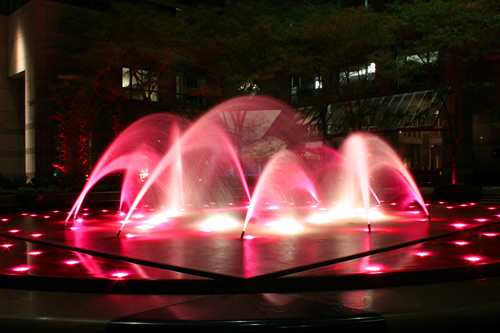
–B Love
|
   
8 October 07: Approaching a fall
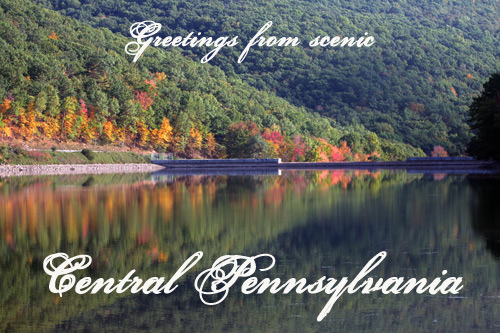
That feeling you felt over the weekend was only masked as Phillies post-mortem . . . No, what you felt was the coming of fall, real fall, with changing colored
leaves and sweaters and pumpkin spice lattes. But Bee Love it was 85°. It's a good point, but let's roll with it anyway.
One of the biggest components of your Philly Skyline has always been the photography, and fall is peak photogenic time. Recall if you will the city wide coverage
of fall 2005, or the weekend in the Wissahickon
last year, or my trip home to Tyrone to be immersed in foliage.
I did the same this past weekend, as seen in the (enlargeable) photo above. This early foliage shot was taken just outside of Tyrone at the Tipton Reservoir, built
in 1920 as a constant water source along the eastern edge of the Allegheny Plateau. The colors are making their way down the mountains to us, and if the last few
years are any indication, they should peak in Philadelphia around the last week of this month or the first week of November. Bookmark the Foliage Network now to stay prepared.
But yes, there was a bit of Phillies post-mortem in there. A lot of people are mad or disgusted or just disappointed, but I'm not. For all that was thrown at the
Phillies, they really did fight through most of it. The Rockies are a team on a mission . . . they just played better. Besides, we still canceled out those
stinkin' New York Mets, and we have a young core. No reason to think the Fightin' Phils can't make the playoffs next year. Speaking of photos, a season recap from
a season ticket holder's point of view is also in the cards.
It's Columbus Day. Here's a red-tailed hawk.
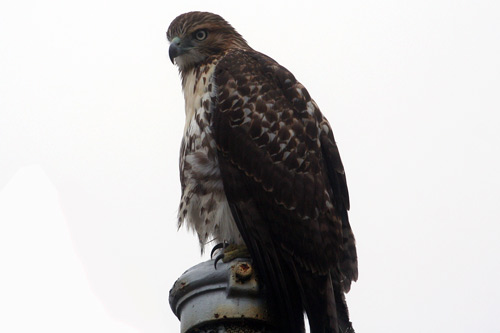
–B Love
|
5 October 07: No other way
|
by Nathaniel Popkin
October 5, 2007
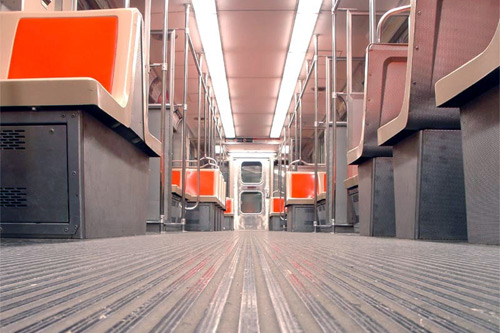
I sat on jury duty last week, spending four days with twelve other Philadelphians (one alternate was dismissed), and of course we talked about everything, from the cleanliness of
restaurant kitchens to grandchildren-grandparent relations to Septa. In those four days we talked more about Septa than the Phillies -- and I never raised the subject once.
This came as a bit of a surprise to me. While Septa reports about 600,000 trips per day, the conventional wisdom is that to get anywhere in Philadelphia you drive (then complain about
the parking); It's always seemed to me that we Philadelphians, as we are about certain other factors of big city life, are ambivalent about transit. Look at listings for events,
movies, restaurants, shows: there's never a transit route(s) included to tell you how to go. From Bucharest to San Francisco that's standard practice.
But no articulation of the Possible City is worth a $.75 transfer without considering a new vision for transit. These days, and in this political climate, it is also the moral and
economic imperative of state and local government to respond to the crisis of global warming. Here's what we are told today by the UN, this from Julian Borger at the Guardian.
As a measure of the worsening situation, Ocha, the UN Office for the Coordination of Humanitarian Affairs -- part of the UN secretariat that employs Sir John -- has issued 13 emergency
"flash" appeals so far this year. The number is three more than in 2005, which held the previous record.
Two years ago only half the international disasters dealt with by Ocha had anything to do with the climate; this year all but one of the 13 emergency appeals is climate-related. "And
2007 is not finished. We will certainly have more by the end of the year, I fear," added Sir John, who is in charge of channelling international relief efforts to disaster
areas.
More appeals were likely in the coming weeks, as floods hit west Africa. "All these events on their own didn't have massive death tolls, but if you add all these little disasters
together you get a mega disaster," he said.
The only one of this year's emergency appeals not connected to the climate was an earthquake in Peru, in August. The others arose after an unprecedented string of catastrophic floods
across much of Africa, south Asia and North Korea, and followed severe drought in southern Africa, Nicaragua's category-five hurricane, and extreme climate conditions in Bolivia, which
brought both drought and floods.
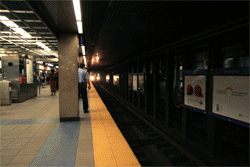 Washington wishes to ignore the crisis; so we are forced to pick up the pieces. So far the courts are giving a green light to far-reaching policy changes intended to drastically reduce
carbon emissions. In this regard, in the perfect world of all perfect worlds, a Governor Rendell, who has proven his credibility in energy policy and who went to bat for transit
earlier this year, would be our champion and together we would do everything possible to remove automobiles from the road. But it is not clear that Septa management is able to see such
a big picture.
Washington wishes to ignore the crisis; so we are forced to pick up the pieces. So far the courts are giving a green light to far-reaching policy changes intended to drastically reduce
carbon emissions. In this regard, in the perfect world of all perfect worlds, a Governor Rendell, who has proven his credibility in energy policy and who went to bat for transit
earlier this year, would be our champion and together we would do everything possible to remove automobiles from the road. But it is not clear that Septa management is able to see such
a big picture.
I should be clear: if Septa were smart enough it would hitch its political future to the drive for energy sustainability. But all we want is a transit system so good it transforms the
very nature of city life.
But the transit agency's near-sightedness may be understandable. One look through Septa's operating reports (available at septa.org)
indicates the complexity of this system, cobbled together from private transportation companies of yesteryear, with several semi-autonomous divisions, 280 stations, 16,000 bus stops,
142 routes, antiquated systems, crumbling bridges, and steadily declining federal subsidy. It's no easy business; maintenance, overhaul of vehicles, and new bus purchases take much of
the capital budget; the poorly conceived Market Street Elevated reconstruction takes a whole lot more. And then? What?
Let's return to our premise. Cities, in reinventing themselves, are obliged to think for themselves, think big, and turn liabilities into assets. That takes force of political will --
the payoff being growth, recognition, new fortunes. So we're going to have to ignore the voices that say, "Septa has trouble getting its shoes on, let alone tying them," and imagine
that a new mayor creates a cabinet-level Transportation Secretary and that City Council populates its dormant Transportation Committee and that these folks coordinate with 1234 Market
and with Harrisburg and with Washington to create and implement a transportation plan for Philadelphia.
With dedicated funding in hand, the time for excuses has passed.
Most people intuitively know what's wrong with Septa. B Love, with his two recent simmering rants, hits on some of the problems. Certainly there are talented policy-makers who have
some solutions, including transforming regional rail into a Riverline-like light rail system, extending the Broad Street subway to the Navy Yard and to the El in the Northeast,
integrating all divisions onto one system clock, installing a new fare card system, etc. There's much to be done; Septa has already considered some of these critical changes. But the
capital budget is long on time and light on impact and so the Broad Street extension, which solves long-term problems for existing riders and which would result in a large number of new
riders, is shunted for the fabled Schuylkill Valley Metro.
Since we're inventing possibilities here, we're going to make some assumptions and then propose a bold change. Let's assume that moral imperative and economic reality combine to put
transportation at the head of the sustainability agenda. Septa management achieves adequate yearly progress; service improves, ridership inches up. This will be a noticeable change
but it won't be enough to transform the experience of city life, which is our considerable goal.
Now let's imagine that Septa's -- and Philadelphia's generally -- learned obsolescence works in our favor. We've gotten so set in our ways, so old-fashioned that we've skipped two or
three generations of policy (like poor countries who went straight from no telephone service to cell phones). To skip incremental change is freedom (in my best imaginings this is what
happens on the waterfront, where through the grace of God we don't build a Festival Marketplace or a casino, but by waiting so long to do something, build an organic extension up to the
rivers edge, as Herbert Muschamp says below, "Philadelphia now breaks ranks with cities that have regressed toward infinite infantilism in the quest to revitalize their downtowns."), is
time to think, is time to take hold of new ideas and technology.
The efficient movement of people is currency nowadays. We are each of us one of six billion needing to go about life with the least intrusion to each other -- and resources are scarce.
The Internet is the best way to solve this problem, but it still leaves us wanting more. We need to be in each other's presence. Can you think of anything else so important? So
transportation is a public good, not a luxury, not a last option. Clean water, clean air, and the capacity to move around freely (without doing harm).
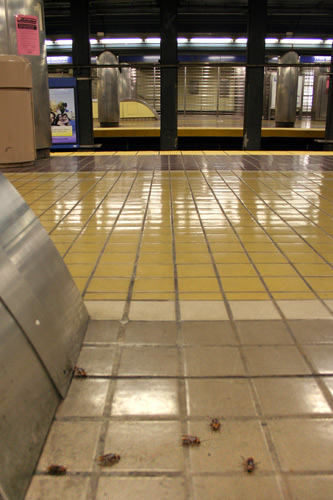 Microchip technology advances as time flies, or so I'm told. It is possible, I imagine, on one little piece of plastic to place a lot of information. So let's invent a special
Philadelphia card, which can be used for transit, museums, libraries, school lunches, gas bills, taxes, rec department summer camp, parking, welfare, etc. We'll call it the Card of the
Availabilities, the city in your pocket.
Microchip technology advances as time flies, or so I'm told. It is possible, I imagine, on one little piece of plastic to place a lot of information. So let's invent a special
Philadelphia card, which can be used for transit, museums, libraries, school lunches, gas bills, taxes, rec department summer camp, parking, welfare, etc. We'll call it the Card of the
Availabilities, the city in your pocket.
Around the world, transit ridership decreases 3.8% for every ten percent increase in fares. This means that when Septa raises fares, as it did this week, it loses riders, but gains
revenue (a 3.8% decrease in ridership on a 10% increase in fares results in a 5.8% revenue increase). But increased revenue isn't the goal of transit. Increased riders is, the more
the better. So in this case, Septa remains financially stable but fails in its mission. The need to collect fares is forcing the agency to undermine its very charter.
A few years ago, I suggested in the City Paper that Septa should eliminate fares altogether
("Let's forget about all this fare nonsense."). I cited the economic and societal cost of automobile accidents and pollution as rationale. Surely, eliminating fares would reduce auto
use, and save us all a lot of money, enough to offset the annual lost of $300+million in farebox revenue. Well the crisis of global warming didn't seem as urgent then; nor did I factor
in the cost of maintaining and building roadways, the $24 million budgeted to upgrade fare collections, the cost of collecting fares (about $60 million based on industry average). Now
eliminating fares seems like the most powerful way to increase the number of riders, massively alter people's experience of Philadelphia, and also reduce carbon emissions from
automobiles.
It turns out there is some precedent for a fare-free approach to transit. Transit was free for a year in Austin, Texas; it is free in the medium-sized Hasselt, Belgium, where the bold
move transformed the city; it is free on certain high-smog days in San Francisco. And SF officials are seriously considering extending the program.
The Austin experiment failed. One of the effects was to increase ridership among rowdy kids, drunks, and other unrulies, thereby making the system less pleasant for regular users. It
increased lines, waiting time, and made buses more crowded. Vandals did regular damage. Ridership, which did increase, began to level off.
One of the fears of eliminating fares is that it won't get people out of their cars but will attract people who would otherwise walk or ride a bicycle and children and youth who may be
improperly behaved. The other is that if a fare-free program is implemented without having made other system-wide improvements, for example without a substantial increase in service,
you'll end up with lines of cursing people.
 This leads us back to the Card of the Availabilities (with a picture of Lou Kahn on one side and City Hall on the other). Assuming Septa has already improved the system enough, the
Card of Availabilities would be your entrance to subway stations, buses, trolleys, etc. It's a free pass; you go anywhere. Don't have a card, you don't go in.
This leads us back to the Card of the Availabilities (with a picture of Lou Kahn on one side and City Hall on the other). Assuming Septa has already improved the system enough, the
Card of Availabilities would be your entrance to subway stations, buses, trolleys, etc. It's a free pass; you go anywhere. Don't have a card, you don't go in.
But would it be free? I think it would be very inexpensive -- say $100 for the year, or $200, covering some of the other services available around the city. It could hold a certain
amount of money and act like a debit card or it could simply cost $100 to purchase (depending on the services you access with it). It's a nominal amount that would eliminate the severe
effects felt in Austin. A certain amount of foresight and a small amount of money would be required to get a card. Once you have card, you just go, under the radical assumption that
the city is yours to access, enjoy, and explore. This just might begin to change the way we live.
There is the question of funding. Eliminating all but a nominal rider-revenue stream while substantially increasing service might cost Septa $400-500 million a year, which sounds like
a lot. In fact it's 13% of the City budget. Factoring in savings from reduced traffic and increases in tax revenue because the city with free transit is healthier, let's say it's
really 10%. But let's assume the city covers $100 million of this missing revenue, the suburbs, who would love to reduce traffic on some roads and the cost of road construction and
maintenance, together another $75 million (they get off cheap, as usual), and another $50 million is saved by not having to collect and process fares. That leaves $275 million. I say
a Clinton administration with Ed Rendell as Secretary of Energy or Transportation finds a way to make it happen.
Of course I punted on this last question. It is nearly impossible to make the case that massive increases in transit use would substantially decrease costs associated with car
accidents, air pollution, road-wear, and the construction of new highways. You can't say, Well, the money comes from X. So the very real problem remains of replacing the revenue. I
can punt again by saying its all about societal priorities; a fairer, more equitable, and less war-like society would easily have $275 million extra for good transit. But what about
education, job training, infrastructure? you ask. So that's a never-ending argument, there's always something to do with it. (I can't wait to stop writing checks to Blackwater and
Halliburton and start writing them to Amtrak, etc.) Septa's direct Washington funding has dwindled from $18 million in 1980 to some $3 million today, but even returning to that level
would amount to a drop in the bucket.
I wonder, though, if ever Washington got serious about using the nation's endless wealth to build great cities, if all of a sudden it didn't seem normal to raise $275 million to provide
infinite free rides. Spending $2.5B a week in Iraq for no credible return has made us believe that nothing imaginative here is really possible. We travel to countless European-Far
Eastern anywheres and say, My God, it's amazing what they're doing, I wish we do could that.
Why don't we do that?
–Nathaniel Popkin
nathaniel.popkin@gmail.com
For Nathaniel Popkin archives, please see HERE, or visit his web site HERE.
|
   
4 October 07: On Herbert Muschamp
By Nathaniel Popkin
October 4, 2007
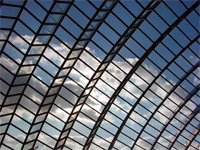 A former Philadelphian died Tuesday and it's worth taking a moment to think about his legacy. Herbert Muschamp was the architecture critic of the New York Times from 1992 to
2004, when some say he was forced out for writing too much about meaning and not enough about form. No one could understand what he was saying. Whether that was true or not,
what is certain is that Muschamp championed the urbanism of movement, expression, and change -- and had no time for regression, detachment, and formula.
A former Philadelphian died Tuesday and it's worth taking a moment to think about his legacy. Herbert Muschamp was the architecture critic of the New York Times from 1992 to
2004, when some say he was forced out for writing too much about meaning and not enough about form. No one could understand what he was saying. Whether that was true or not,
what is certain is that Muschamp championed the urbanism of movement, expression, and change -- and had no time for regression, detachment, and formula.
There are Philadelphia architects who got caught in his claws and they like others in New York quickly built a disdain for him. But not me. My wife Rona and I would read his
columns aloud to each other (as we did his obituary this morning), surprised and excited that someone with such a pulpit should "get it." What Muschamp got, I believe, was
an essential understanding of the power of the city to take a role in both an individual's life and in the cultural dialog. The city ought to answer back, and when it stops
doing so -- when architects remove themselves from the urban conversation -- it loses power and relevance in our lives.
Muschamp's replacement, Nicolai Ouroussoff, ends his obituary this morning with this quote:
"We were the children of white flight, the first generation to grow up in postwar American suburbs. By the time the 60s rolled around, many of us, the gay ones especially,
were eager to make a U-turn and fly back the other way. Whether or not the city was obsolete, we couldn't imagine our personal futures in any other form. The street and the
skyline signified to us what the lawn and the highway signified to our parents: a place to breathe free."
It strikes me that the city signifies just this to so many of us, freedom to conceive of the American life in a different way, and to live it too.
Here is Muschamp's critique of the Kimmel Center: NYTimes.com.
For Nathaniel Popkin archives, please see HERE, or visit his web site HERE.
|
4 October 07: Remember the Tarp
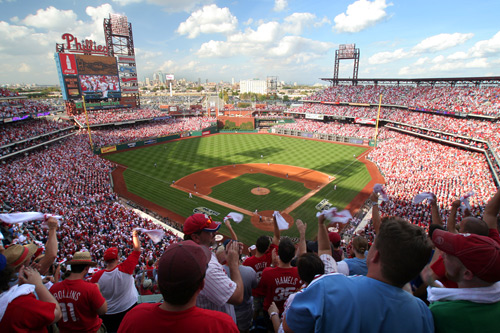
Well, a loss to open the National League Divisional Series is not the way anyone wanted the Phillies to start their first postseason run in fourteen years, but the series
is long from over and there were some positives from the game. Like? How about this morning's Philly Skyline Phillies Skyline. Click that photo to enlarge happy times at the
ballpark as Aaron Rowand approaches home plate on his fifth inning homerun with the Philly Skyline out yonder.
Pat Burrell followed that up with a "Burrell Bomb", a new scoreboard graphic apparently either created just in time for tv networks to air it, or salvaged from the '02
season at The Vet when he garnered his contract with a .282/37/116. One bad inning aside (which could have been really bad if Matt Holliday's grand slam foul ball was
about 20 feet to the right), Cole Hamels looked good. There were some nice defensive plays (Rollins, Helms, Howard).
But that's about it. The Rockies controlled the game and Jeff Francis was stellar. It's hard to win when the top four hitters in your lineup go 0-for-16, including a
shocking four strikeouts by Chase Utley.
But that's yesterday's news, today is today, and the Phils have unshakeable Kyle Kendrick going against Franklin Morales, same bat time (3), same bat channel (TBS, as in
Total Bull Shit that the Braves' station gets to broadcast Phillies playoff games).
Dig deep, Phillies -- remember the tarp! Show those lowlife, classless bums how to play! Go Phillies!
–B Love
|
   
3 October 07: Your Skyline now has more Perelman
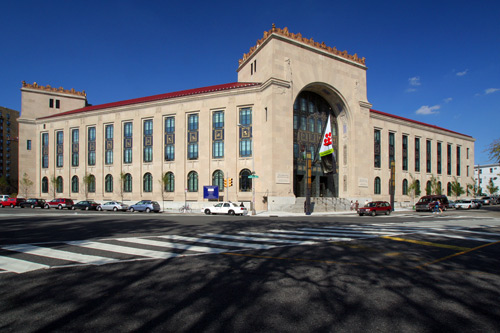
Less than three weeks ago, the Philadelphia Museum of Art opened the doors to its brand spankin' new Ruth and Raymond G Perelman Building to the public for the first time.
Thousands came to satisfy a curiosity that built over the course of seven years. The New York Times oohed. Inga Saffron ahhed. Philly Skyline said hooray and made a
PMA/Perelman aerial Philly Skyline Philly Skyline.
I personally waited it out because, Phillies games aside, I'm not into really large crowds. Thankfully, GPTMC got me off the schneid to accompany a
group of visiting journalists including Jean Aw from Notcot, Liza Monroy (who's written for Jane and Bust), and Philly's own Caroline Tiger, who operates Design Phan.
Indeed, the Perelman was a long time coming, and it had all the build-up and marketing blitz one would expect from a large, wealthy institution as the PMA. And baby, does it
deliver.
Philadelphia is an art-at-heart town, from the PMA to the Rodin to PAFA to the Art Institute and UArts and Moore to the 1% for Art Program to Old City on First Friday to the
Crane in Kensington to the knocker on your front door. We have relics, we have classics, we have genre makers, we have avant garde, we have new and we have weird. We can't
get enough, but we can satisfy pretty much any urge.
That's why I was shocked to be as impressed by the Perelman as I was. I don't recall the last time I left a museum for the first time with a need to tell -- text
message -- friends "run, don't walk."
The art deco building hugging the wide corner at 25th & Pennsylvania with its dual arches has always been worth an extra glance when flying by on Kelly Drive, but the
opening of the Perelman's galleries feeds a reason to stand under its arches and analyze its ornamentation, representative of family, life, industry and Pennsylvania in the
Roaring Twenties. The 1927 building, designed by Zantzinger, Borie & Medary (who were also heavily involved at the PMA, which opened a year later, and the Philadelphia
Parkway, which would of course be renamed for Ben Franklin a decade later) and built by Turner Construction (who is of course still around -- they built The Linc and
Cira Centre and are building Murano), has its own mini-display and film depicting its history and symbolism at the bottom of the rectangular spiral stairwell.
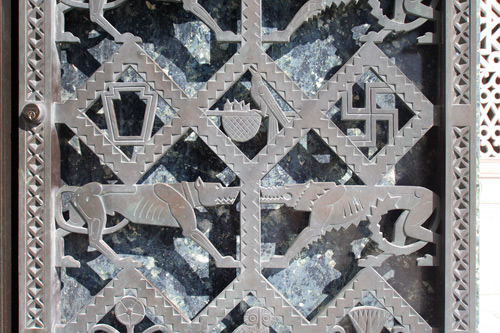
One thing I found surprisingly absent in its glossary of deco motifs was mention of the swastika. While most people with even the slightest background in art history know
that the swastika is an ancient and sacred symbol with traces to early Hinduism and Buddhism, as well as Troy and ancient Greece, the past century has obviously shifted
the general perception of the swastika to represent fascism, racism and the Holocaust because of its adoption by Hitler's Nazi Party in Germany. The swastika was especially
popular in architecture in the early 1900s as a symbol of good fortune and protection; you can see it in many Philly buildings of this era, including the front plaza of the
Art Museum. But to expect large groups of the public, in particular schoolchildren, to know this history or associate it with anything but Hitler, especially when
there is an entire display explaining the other symbols like the keystone, the mother and baby birds, and the dogs . . . well, they're inviting the same question to be asked
repeatedly.
That minor nitpick aside, the Perelman is just fantastic. Gluckman Mayner's addition in what was open outdoor space is subtle and masterful, not wispy and goofy like a Gehry
or Libeskind. (I think it's great that we'll be able to say we have a Gehry in Philadelphia when it's completed at the PMA . . . and even greater that it's underground.) The
brick used on the outside wall of the skylit galleria seamlessly extends the original outer wall, but its inverted angle reminds you that it's 2007. John Chamberlain's
Glossalia Adagio draws you there from the golden lobby. Joan Miro's Lunar Bird leads you toward the other end, with the Joan Spain Gallery of costume and
textiles, the Julien Levy Gallery for photographs, and the Collab Gallery for modern and contemporary design on your left along the way. The last of these the highlight of
the museum, with its debut exhibit Designing Modern: 1920 to the Present featuring furniture, posters, accessories and the like from Howe & Lescaze, Eero Saarinen,
Robert Venturi, several Bauhaus and postmodern auteurs arranged in chronological order.
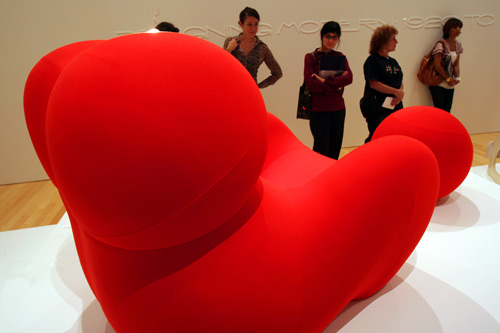
Well done, PMA. The Perelman is a wonderful addition to the Philadelphia art scene, and thanks to Wachovia, it's free until the end of the year.
In a variation on an old theme, a mini photo essay of the Perelman is HERE, but the variation is that all the photos are Philly Skyline Perelman
Skylines, i.e., click em all to enlarge em all.
(A special thank you to Caroline and Morgan.)
GO PHILLIES!
–B Love
|
2 October 07: Smooth as Septa
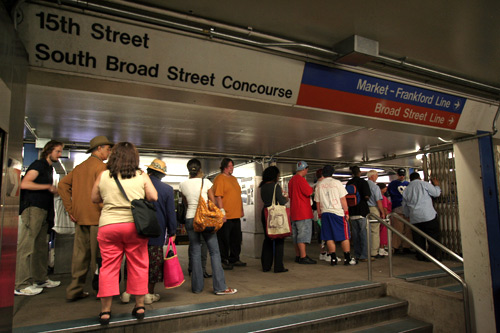
Good ol' Septa. They did vote to raise your fares, and they did raise your fares.
Beginning yesterday, the cost of transfers and tokens went up fifteen cents, and it was pretty much a direct answer to the court order which required them to keep the paper
transfers they so wanted to eliminate. That may be a piddly raise, but with thousands and thousands of token and transfer purchases a day, Septa expects it to add up to plug
a hole in its operating budget. But by the same token (sorry), the people who live by those tokens and transfers will be ponying up fifteen cents more every time out,
and that also adds up.
Whatever. A 75 cent transfer is easier to make change (or have change) for, and $1.45 for a token is still better for the casual rider than $2 every time out. It's Septa's
handling of the whole thing. It's always Septa's handling of these things. Machines don't accept "new" bills? Eliminate the machines! Transfers are a hassle? Eliminate
transfers! Get a very substantial $150M annual raise from the state? Raise fares anyway!
So with hundreds to thousands expected at the Phillies rally at City Hall -- directly above the Subway, El and every trolley, and a quick walk away from Suburban and Market
East Stations, where every single regional rail line passes through -- the fare hike would be a smooth transition, right?
Ha ha ha ha ha ha ha ha ha ha ha ha.
The line in the photo above is not, in fact, droves of new patrons eagerly awaiting a ride with the nation's hottest transit agency. No, those are people standing in line
because they have to -- the token machines didn't work. Of all the token machines at 15th Street, only one was even turned on.
Not paying any attention to the line or the heated voices, I started to put a dollar into that one machine when I heard a voice say "it's not working." Puzzled, I turned to
this man in a tucked-in polo shirt which had no Septa insignia or any indication he was with them, and said "are you sure?" He sternly said "yes, you have to go to the ticket
window" and pointed down toward Suburban Station. Uh, yeah. I'm going to walk all the effin way through Suburban Station to get tokens for a ride whose turnstiles are twelve
feet from where I stand. Right.
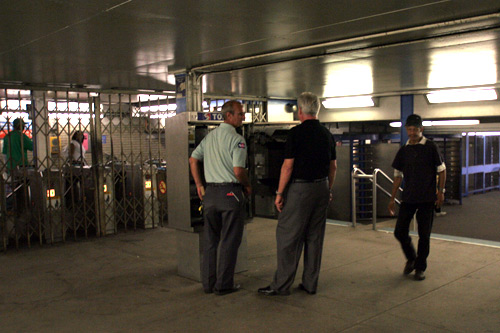
By this time, Polo Shirt Man is joined by an actual Septa worker (both pictured above) who's there to do . . . something to the token machine. Fix it? Upgrade it? I
don't know.
The signs on the machine did not yet have the new fare posted, but it didn't matter anyway since they didn't work. So you had to stand in line. At the one booth that was
open. On the day they raised the fares. At the end of a Phillies rally with over a thousand people right upstairs. With an attendant whose broken English was not as humorous
as Apu Nahasapeemapetilon's.
While I was waiting for my turn, a girl in front of me was trying to explain to this man that the same token machine I was told to walk away from ate her dollar bill, and
she was trying to get that bill back. The man told her she had to fill out this form, but wouldn't let her borrow his pen. Lots of Fs ensued.
I didn't stick around to see if she got her bill back, but I did observe, after paying my two dollar base fare, that the line had doubled, and that for all the Septa workers
in the station area, they made no move to open another booth, or even have someone a little faster in conversation assist in the one that was open. Imagine if Joey Vento
rode the El!
And I'm sure it's all fixed now (actually, no I'm not), but the whole scene was par for the course, a drop in the bucket of Septa's self fulfilling woes. The excellent blog
Septa Watch has racked up over 170 posts since only April . . .
This blog's third posting ever, back on April 19, lamented the leaking pipe in the City Hall concourse. It started raining a little bit this morning so, 170
posts later, I checked in on it.
It's still leaking. If the rain keeps up, later today, the water will start running down the stairs onto the BSL platform.
With the extra 15c SEPTA will take from me for my token [this] week, perhaps it can buy some chewing gum to plug that leak.
Remember Live 8?
And how great the city was that day, and how smooth everything ran? Septa was the one pock on that otherwise perfect day. Overcrowded platforms, trains not long enough to
handle the number of passengers, overburdened conductors . . . That's the other thing: I actually feel bad for the drivers and conductors on the system, because they're
very good at what they do.
Saying Septa sucks is like saying the sky is blue or that 2 + 2 = 4. But it doesn't have to, and I wish it didn't. We all wish Septa did not suck. But . . . Septa sucks. And
until someone who knows how to run it as effectively as let's say Boston's or Washington's or even Portland's transit agencies (I chose those three cities because they're
smaller than Philadelphia . . . NYC and Chicago should have better run transit systems than we do) comes along to save it, we're stuck with it.
–B Love
|
1 October 07: Phillies fever at City Hall
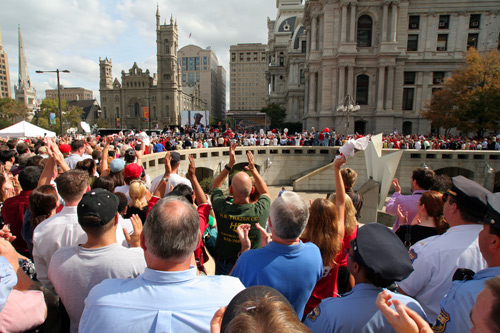
What I really want to know is: can Mr Greengenes get some? I said, can Mr Greengenes get some???
Pennsylvania's longtime favorite cover band knocked out stadium classics "Boys of Summer" and "We Will Rock You" (with the Phanatic handling the Brian May solo) to lead into
the pep rally on City Hall's Dilworth Plaza today at noon. Some quotables from the event . . .
• "I hope you guys had fun partyin' up last night." -Aaron Rowand
• "Is that Vanilla Ice?" -A fan when Jayson Werth was introduced
• "BOOOOOOOOOOOOOOOOOOO." -Every single person in attendance when Mayor Street was introduced.
• "Hey, where is Chris Wheeler?" -Absolutely No One.
• "Out on the road today, I saw a Greengenes sticker on a Cadillac." -Mr Greengenes' singer during "The Boys of Summer"
• "What's up man?" -CDoc
• "Chillin man, how you bean?" -B Love
• "This is fun, but I'd like to have a couple more parties here, and right down Broad Street." -Jimmy Rollins
• "MVP! MVP! MVP!" -Everybody's response to Jimmy Rollins.
Really now -- the Phillies' time is now. If you're not already here, get on board! THRASH!
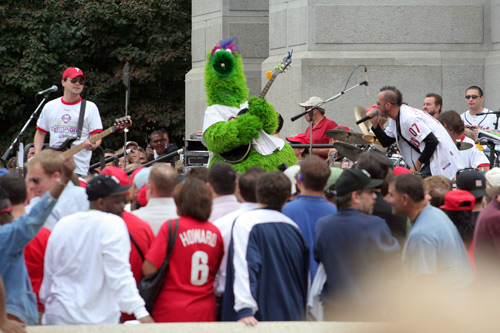
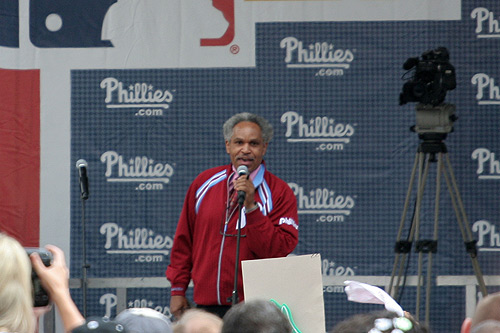
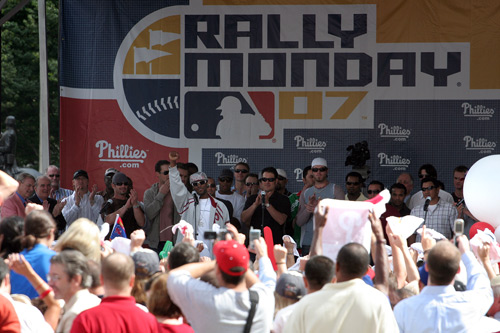
Click that last one to PSPS it up and get on board. The playoffs are right here in Philadelphia, baby.
–B Love
|
1 October 07: October is ROCKtober, YEAH!
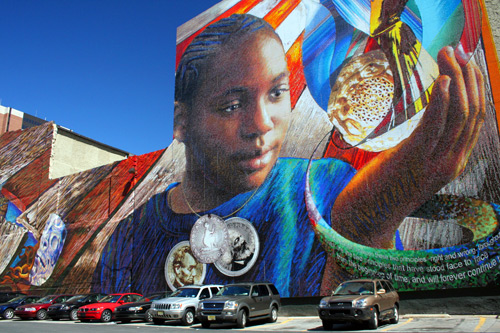
Autumn is almost always my favorite time of year, in spite of the most impure fantasies exaggerated by the first crisp downtick in temperature and the explosion of color all
around. Visions of goats and kaleidoscopic rainfall and bare breasted babes in the woods collide with anxious anticipation of the unknown and questions of race and guilt,
neither mutually exclusive . . . beware out there. Ho ho.
But this October, and every October, the clash of color and existence finds safe harbor in Bank of America Mural Arts Month.
Most Philadelphians have at least a passing fondness for the murals that make us the City of Murals, but how deep does that fondness go? Speaking personally, I've always
loved seeing the different styles of murals (thanks, I think, more to the varying styles of their artists rather than the different themes they depict) across the city, but
I don't know that I could pass an exam on the history of the Mural Arts Program or rattle off more than half a dozen artists who've painted the murals.
That's where Mural Arts Month works. All these awareness months are good for just that: awareness. I am grateful.
Mural Arts Month begins today because October begins today. Word is bond. There is a list of events to choose from, including nine new mural dedications (from North Philly
to Southwest Philly to G-Ho back up to Olney) and mural tours with the likes of Monica Malpass, Larry Platt, Michael Nutter, Al Taubenberger, and a "special sports celebrity
guest". My money's on Jon Runyan, who I understand is Built Ford Tough.
The subject of this morning's Philly Skyline Philly Skyline became an instant classic when it was dedicated in January 2006. Lincoln Legacy Project, on Chestnut
Street between 8th & 7th, is the eponymous mural of the project which "fuse[s] civic education, community discussions, and artwork centered around Lincoln's legacy and its
relevance today" and which was funded by Lincoln Financial. Click the mural. Enlarge the mural.
Show Mural Arts some love this month, and check out the full list of events HERE.
* * *
Rocktober is also Breast Cancer Awareness Month, so keep your eyes on the Skyline (you see what I did there) for the pretties in pink. It'll be fun to see if the
unfinished Comcast Center unveils its first evening color variation as Cira Centre did when the Eagles were in the Super Bowl. It'll be more interesting to see whether they
go with pink for breast cancer or red for the FIGHTIN' PHILS.
* * *
Last call: if you'd like to and haven't done so, please have a look at the Philly Skyline essay on Port Richmond's Conrail Yards, done in collaboration with CDoc from Ruins. It's an over 200 acre piece of post-industrial riverfront land with nearly a dozen piers jutting out into the
Delaware, and it sits for the most part dormant. We'd like to know how you envision it. (A big thank you to everyone who's participated so far -- I'll reply to your emails
directly shortly.) A background, some maps, and 67 photos are HERE.
–B Love
|
   
30 September 07:
THE TEAM TO BEAT: NL East Champs!
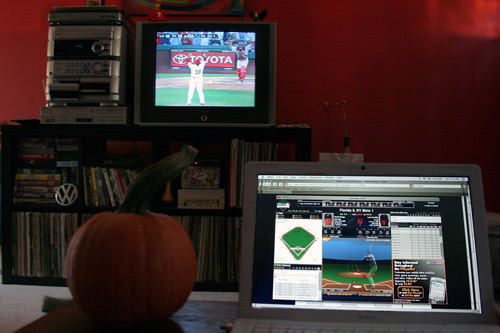
AHHHHHHHHHHHHHHHHHHHHHHHHH!!!!!!!
Breathe.
Holy cow.
AHHHHHHHHHHHHHHHHHHHHHHHHH!!!!!!!
Jimmy Rollins, National League MVP.
Matt Holliday's outstanding season for Colorado notwithstanding, Rollins' play in Sunday's deciding game should be all the proof the baseball writers need to make it
official. J-Roll was amazing down the stretch, but particularly in the clutch. He led off all three games against the Braves with hits, and in the clincher today against
the Nats, he manufactured his own runs AND got his 20th triple of the season to become only the fourth player in MLB history with 20 HR, 2B, 3B and SB. Plus he's a leadoff
hitter with 94 RBIs, thanks half in part to being the clear leader of an offensive minded team, and half to the fact he blew away the MLB record for at-bats in a season,
ending with 713, eight more than Willie Wilson in 1980, the year Tug McGraw struck him out to clinch the World Series for the Phillies.
All together now: MVP! MVP! MVP!
Also, this has to be said: Charlie Manuel has done one hell of a job. To anyone who's watched the Phillies play this season, that's not exactly a revelation, but to longtime
Skyline readers, my saying this is a pretty big admission. Uncle Cholly still made some boneheaded decisions this year, but they paled in comparison to his cool head and
clear direction of an emotional team that often needed it. If he wins Manager of the Year, I will happily eat crow, because he deserves it.
But speaking of eating crow, never mind me. Right now, at 5 o'clock post-meridian on Sunday the 30th of September, I'd like to turn everyone's attention to the New York
Post's Sunday edition from exactly five weeks ago, specifically to this column:
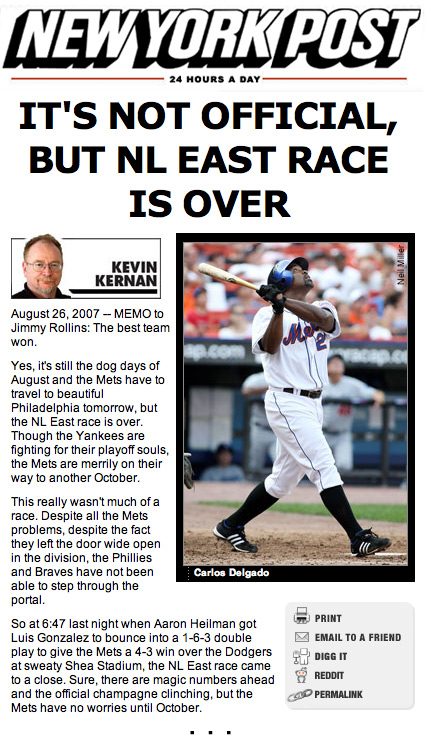
(Click that image to go to the full story at nypost.com.)
This ridiculously arrogant column continues with such quotes as "The Mets simply have more weapons than anyone else in the East", "The Mets biggest challenge is to stay
interested in the final five weeks of the season and to have the eye of the tiger when they get to the postseason" and "'We're in a great position,' Glavine said. 'All we
have to do is take care of business and win our games and it doesn't matter what anybody else does.' . . . Considering the talent disparity in the division, it never really
mattered."
Ah yes, that NL East disparity. The Mets are so talented that no one else had a chance. Just like last season, when they ran away with the World Series. Oops, my bad. I
meant with the NL East, only to watch the Cardinals win the pennant on the green grass of Shea Stadium en route to their World Series win. Anyway, the best part of that NY
Post column is that its author, Kevin Kernan, concludes it with his email address, kevin.kernan@nypost.com. Maybe you'd like to drop ol' Kevin a line and remind him that, in
fact, the NL EAST RACE IS OVER. I did.
But screw Kevin, it's Phillies time. Their divisional playoff series begins right here at Citizens Bank Park on Wednesday with the winner of a one-game Wild Card playoff
between the Colorado Rockies, who stayed alive today with a win over NL West winner Arizona, and the San Diego Padres, who as Gary Matthews pointed out a number of times
today, did NOT pitch Cy Young shoo-in today and paid for it, losing in Milwaukee. Who cares who it is, bring em on. The Philadelphia Phillies are in the playoffs,
BOYEEEEEEEEEE!
* * *
Some other end-of-the-regular-season observations from someone who attended 23 games and watched just about all 139 other ones . . .
• Pat Burrell deserves consideration for Comeback Player of the Year.
• Cole Hamels is amazing and has a long career ahead of him. His curveball on Friday was, as Sarge said, filthy.
• Ryan Howard can strike out twice a game as long as he keeps putting up the numbers he does, especially in the clutch down the stretch, just like he did last year. By
not striking out today, he avoided becoming the first player in MLB history to strikeout 200 times in a season. You know what? That's a fair tradeoff for 47 HR and 136 RBI,
which won him the NL RBI crown.
• JC Romero, Tom Gordon and Brett Myers down the stretch: wow.
• Tom Glavine may be the Hall of Famer, but Jamie Moyer had his number this year, most especially on the last day of the year, when he didn't give up a single earned
run, but Glavine was knocked out in the first inning, costing the Mets the game and their season.
• For the 115th time, Jimmy Rollins > Jose Reyes, so get lost, Wheeler.
• Comcast Sportsnet > Fox Sports & ESPN. Thank goodness for 1210AM when the Phils are on nationally televised games. Fox's no-name idiots (and Tim McCarver) are bad,
but not quite as bad as Jon "Barry Bonds" Miller and Joe "Joe Morgan" Morgan on ESPN Sunday Night baseball. Harry Kalas is a Hall of Fame announcer. None of those other
clowns are. I'd rather listen to the acclaimed broadcaster, thanks.
Wow. The Philadelphia Phillies are in the playoffs.
THE PHILLIES ARE IN THE PLAYOFFS! AHHHHHHHHHHH!!!!!!

–B Love
PS: FYI, our Comcast Center section had itself a big update this weekend.
|
|





























